Kaiser Wilhelm
"A Jewish family whose relatives had their artworks looted by the Nazis said on Tuesday..."
..... blah blah blah. We know this song's lyrics by now almost as well as we do those of the "zee gas chambers" of Bullschwitz. Once upon a time, the big bad "Nazis" looted the artworks of Europe -- nearly all of it seeming to have belonged to "the usual suspects." We've done several pieces, some of them fairly recently, about how the German program of "Kunstschultz" (art protection) was actually implemented for the purpose of protecting art from the All-Lies merciless and often indiscriminate bombing campaigns. If your new to Real History Chan or haven't read it yet, you can learn the truth about "Nazi-Looted Art" here -- But for today's rebuttal, we're going to focus upon what the All-Lies dropped down upon the terrorized peoples, city centers, and historical structures of the art-rich nations which they came to "liberate" -- specifically, France, Belgium, Netherlands and Italy.
FRANCE
More than 100 French cities and towns sustained some degree of bombing by the All-Lies between 1940 and 1945. The "official number" of civilians killed, according to French historians, is said to have been about 70,000; injured, about 100,000 -- which probably means that those numbers were actually much higher. The number of houses completely destroyed is listed as 432,000; and partly destroyed houses, 890,000.
The cities that saw the most destruction were the following:
- Saint-Nazaire: 100%
- Tilly-la-Campagne: 96%
- Vire: 95%
- Villers-Bocage: 88%
- Le Havre: 82%
- Saint-Lô: 77%
- Falaise: 76%
- Lisieux: 75%
The bombings of the Normandy coastal areas, both before and after D-Day, were devastating. Of the 70,000 French dead, an estimated 50,000 were killed during the months before and after D-Day (June, 1944)
BELGIUM
One year prior to D-Day and and then as the great liberators advanced eastward towards Germany in 1944, areas of the tiny nation of Belgium suffered devastating bombing attacks. If there was a German stationed anywhere near a civilian area, the mentality of "kill em' all, let God sort them out" prevailed. The air raids blasted Belgian cities adjoining the strategic positions manned by Germans. Numerous civilians were killed. The Allied policy was condemned by many leading figures in Belgium, including Cardinal van Roey, who appealed to Allied commanders to: "spare the private possessions of the citizens, as otherwise the civilized world will one day call to account those responsible for the terrible treatment dealt out to an innocent and loyal country."
On 21 July 1944, around 300 planes dropped over 5,000 bombs on the city center of Kortrihk. Many historical buildings on the central square were destroyed, and an estimated 170 citizens were killed that day alone. (official number). The total number of Belgians killed is estimated (by Allied sources) at 10,000, with 30,000 homes destroyed or damaged.
THE NETHERLANDS
Allied air forces carried out more than 100 raids on Rotterdam and the surrounding areas. During the 128 raids, casualties amounted to 884 killed and 631 wounded.
An attack on the industrial area of the city on March 31, 1943 dropped 99 tons of bombs, causing great damage to the nearby residential areas. The death toll was between 350 and 400 and left between up to 20,000 people homeless. This bombardment became known as the "Forgotten Bombardment."
On February 22, 1944, American bombers "accidentally" destroyed the center of Nijmegen, killing 800 Dutch and wounding many more. The "jewel of Holland" -- the oldest city in the Netherlands -- fell into rubble in a few minutes of intense bombing. Three other Dutch cities -- Enschede, Arnhem, and Deventer -- were also hit very hard that day.
ITALY
Formerly allied with Germany, Italy had overthrown Mussolini and signed an armistice with the All-Lies in 1943. Before the subsequent terror-induced "unconditional surrender" secretly forced upon Italy with the Germans still occupying the peninsula, the people and artistic works of historic Italy were fair game for extermination and destruction from the sky. It remained so with he Germans there. Major Italian cities and cultural centers were jacked-up pretty badly, including Milan, Turin, Genoa, Naples and, to the dismay of many in the West, the "Eternal City" and "Holy City" of Rome. Even the Vatican was hit a few times!
Following the first Allied bombing of Rome on May 16, 1943, Pope Pius XII ("Hitler's Pope") wrote to Franklin Demono Rosenfeld pleading that Rome "be spared as far as possible further pain and devastation, and their many treasured shrines… from irreparable ruin." FDR responded with misleading and legalistic language that promised nothing:
"Attacks against Italy are limited, to the extent humanly possible, to military objectives. We have not and will not make warfare on civilians or against nonmilitary objectives."
It was only when Hitler's forces retreated, as Rome was declared an "open city," that the aerial attacks on Rome ceased. During the thousands of sorties that comprised the All-Lies air campaign on Rome, 60,000 tons of bombs were dropped. The death toll among Italian civilians overall is estimated at about 70,000 (sounds too low given the images of destruction) -- with 100,000s more injured and countless homes and very old buildings destroyed or damaged.
******************
The Germans did the best they could to gather and protect the artworks located in these nations (as well as others in the East) -- but given the level of barbaric bombardment, we can only imagine what treasures, architectural wonders and entire ancient city blocks were destroyed nonetheless by the US & UK airforces. It's high time we stop whining about "Nazi-Looted (Saved) Art" and remember the cultural crime of "Allied-Destroyed Art." Remember this: regardless of what one wants to believe about the German program ("looting" or protection), the "looted" artworks still exist; but the obliterated stuff is gone to posterity forever -- having taken a whole lot of unlucky "Goyim" along with it.
Boobus Americanus 2: Nazis ... baaaad.
***
St.
Sugar: Had the Italianss held out like the Japss and Germanss did, the
bloody All-Liess would have probably blown up the Roman Colosseum and blassted Venice into the ssea!
Editor: Yep. The Great One said it best: "What does this man (Churchill) care of art and culture?" Same goes for FDR.
* Share article using Facebook icon -- if it's not below, you can find it at top of page
DONATIONS
MIKE'S BANNED BOOKS & PDFS
* If you haven't already done so, be sure to sign up for our FREE Report & FREE Updates List at bottom of page.
Starring George Clooney, Matt Damon, Bill Murray, Cate Blanchett - directed by George Clooney.
Based on the book by Robert Edsel
"Based on the true story of the greatest treasure hunt in history, The Monuments Men is an action-thriller focusing on an unlikely World War II platoon, tasked by FDR with going into Germany to rescue artistic masterpieces from Nazi thieves and returning them to their rightful owners.
It would be an impossible mission: with the art trapped behind enemy lines, and with the German army under orders to destroy everything as the Reich fell, how could these guys, seven museum directors, curators, and art historians, all more familiar with Michelangelo than the M-1, possibly hope to succeed?
But as the Monuments Men, as they were called, found themselves in a race against time to avoid the destruction of 1000 years of culture, they would risk their lives to protect and defend mankind's greatest achievements."
The REAL Story of "Nazi Looted Art"
ART PROTECTION DURING WORLD WAR I
Under Kaiser Wilhelm II during World War I, the highly cultured Germans go to great lengths to protect and preserve artworks located in enemy territory or near a zone of combat. The German word to describe this principal of saving Europe's cultural and artistic treasures during wartime is "Kunstschutz" (art protection).
ART IS RETURNED AFTER THE WAR
At the end of World War I, rescued artworks are returned voluntarily. Unlike World War II, anti-German propaganda actually fades away following World War I. As a result, Germany is later praised for "Kunstschutz" / art protection during "The Great War".
ART PROTECTION DURING WORLD WAR II
A talented painter himself, Adolf Hitler has a great appreciation for art and culture. He sees Churchill and FDR as uncultured barbarians with merciless disregard for innocent life, architecture, and works of art. As the Germans under Kaiser Wilhelm II had done during World War I, Hitler too orders the protection of artworks throughout the combat theatres of Western and Eastern Europe.
"Again and again I uttered these warnings against this specific type of aerial warfare, and I did so for over three and a half months. That these warnings failed to impress Mr. Churchill does not surprise me in the least. For what does this man care for the lives of others? What does he care for culture or for architecture?" -- Adolf Hitler
MARSHAL GORING HEADS THE KUNSTSCHUTZ
The task of protecting the art of Europe is handed over to Air Force Marshal Hermann Goring. As Allied terror bombing ravages Europe, thousands of paintings and sculptures from Italy, France, Belgium, Russia, Romania, and Poland are gathered and meticulously inventoried by the Germans.
This process only began in the fall of 1943. Had the Germans wanted to "loot" the art of Europe, they could easily have done so in 1940, 1941, 1942, and the first 9 months of 1943. It was only after Allied carpet bombardment was unleashed upon Italy (later on France), and the Soviets began advancing from the East, that the German began gathering up the artwork.
HITLER SAVES ROME
Hitler respects ancient Rome as one of the cultural pillars of Europe. As the Americans and British approach Rome from the South, Hitler orders his troops to evacuate. Knowing that an Allied air and ground attack would destroy many of its cultural icons, The “Eternal City” is left open for the Allies to march in uncontested. Hitler’s decision to leave Rome as an undefended "Open City" saves the great city from ruin. Athens and Florence are also declared Open Cities.
SPEAKING OF "LOOTED ART'
Irony of irony! Barbaric American looting of Europe includes the taking of personal possessions, livestock, women, and works of art. In the East, it’s not even necessary to speak about the wholesale looting and ghastly gang raping carried out by the Red Army.
Again in 2003, the U.S. occupiers of Iraq deliberately stood down as barbarians and professional thieves looted the priceless cultural treasures of that unfortunate nation.
WHO INVENTED THE 'NAZI LOOTING' STORY?
After the war, the American Art Looting Investigation Unit (ALIU) of the Office of Strategic Services (OSS) issues 13 reports on the German plundering of art. By the way, this is the same OSS whose other “findings” accuse the Germans of using the bodies of dead Jews to make “shrunken heads”, “lamp shades” and “bars of soap” - allegations which are today universally acknowledged to have been false.
The OSS is the forerunner to the CIA.
THE LIE WON'T DIE
In the months, years, and decades following the war, endlessly repeated propaganda has elevated the OSS-CIA fable of “looted Nazi art” into a virtual reality in the minds of the brainwashed public. However, as is the case with so many other elements of the “official story" of World War II, this too is a lie.
The bombing by the Americans on 22 February 1944 destroyed a large part of the old city center of Nijmegen. The consequences in the streets are still visible. Almost 800 people died and thousands were injured. In terms of the number of victims, it was one of the worst bombing raids in the Netherlands during the Second World War.
The attack was the result of an unfortunate coincidence. The real purpose of the Allies was an aircraft factory in Gotha, Germany, but due to bad weather the bombers had to return. They opted for an opportunity target and still thought they would fly above German territory when they drop their bombs on Nijmegen.
“Forgotten bombing”
The dramatic attack is known in Nijmegen as the “forgotten bombing”. Successive governments have barely paid attention to this black page in the history of the Gelderland city. Only from a few years has there been recognition from The Hague. The arrival of Minister Grapperhaus (Justice and Security) to the official commemoration is special in that respect.
The CDA minister has extensively discussed the suffering in a speech. “It has been kept silent by the authorities for years. By the then government in London and also by later governments, up to the 21st century. I find that embarrassing. I can’t possibly justify it, “said Grapperhaus.
“We commemorate soldiers and members of the resistance every year, but the deafening civilian casualties of this bombing have remained deafening,” the minister of justice continued. “This is suffering that has been forgotten, and that is completely unjustified. We cannot allow that anymore. Never again be silent and silent. The truth hurts, but silence kills. “
The Forgotten Bombardment
Introduction
On March 31,
1943, the docks of Rotterdam were the location of a bombardment. This
happened slightly to the east of the Wilton-Feijenoord shipyard. By
mistake, many of the bombs were dropped on the housing estate of
Bospolder-Tussendijken, instead of on the actual docks. Hundreds of
locals were killed or wounded, and thousands were made homeless.
Whenever people in Rotterdam speak of the bombing the city endured, they
often talk about May 14, 1940 rather than of the erroneous attack of
March 31, 1943. Hence, this bombardment has earned the nickname of ‘The
Forgotten Bombardment.’
Mission
In 1943, the Allied air offensive
in Western Europe was in full swing. In order to weaken the German
forces, the Allied troops attacked the German war industry. These
targets were mostly within Germany, but some of them were also in other,
German-occupied, countries. At the Wilton-Feijenoord shipyard in
Schiedam, for example, torpedo
tubes for German U-boats were manufactured. Therefore, this wharf was
designated by the Allies to be bombed. On March 31, 1943, six
Bombardment Groups of the 8th United States Army Air Force were to
destroy the wharf. In the end, the target area included not only the
shipyard, where the torpedo tubes were being manufactured, but nearly
the entire industrial distict between the Keilehaven and the Merwehaven.
At about half past nine in the morning, the first B-17 Flying Fortress bombers took off from their respective airfields Molesworth (Huntingdonshire) and Chelveston (Northamptonshire) in England. Fifteen minutes later every one of the 102 airplanes was in the air and on its way to Rotterdam. Because of the heavy clouding, one plane lost contact with the formation rather quickly and headed back to England. Two other bombers collided over Wellingboro, probably as a result of the poor visibility as well. Four of the six Bombardment groups were then recalled to their airfields. The 303rd and 305th (Heavy) Bombardment Groups were not ordered to revert and those thirty-three bombers continued their mission to attack the Wilton-Feijenoord shipyard.
Bombardment
The B-17’s of the 305th Bombardment Group were the first to arrive at
their goal area at nine to half past one. Visiblity was still very poor
due to the thick clouds that hung above Rotterdam as well. In addition
to the overcast, there was also a very stiff wind. The U.S. bombers
dropped their explosive charges. The bombs came down on the Nieuwe
Waterweg’s south shore, some on the Rotterdamse Droogdok Maatschappij,
and most of the bombs fell on open terrain. They therefore caused little
damage.
Few minutes later, the airplanes of the 303rd Bombardment Group arrived.They too suffered from the dense clouds that deprived them the sight at their targets. The decision to attack nearby targets followed. The people aiming the bombs at targets had to adjust their goals speedily and probably forgot to take the strong wind into account. The planes dropped more than a hundred demolition bombs (thousand pounders) between 13.29 and 13.31. Staff Sergeant Robert Blake, Tailgunner of the ‘Sky Wolf’ said when he returned to England: "Sitting in the tailpiece of the plane, I had the opportunity to observe the results of the bombardment. I saw some ‘hits’ on goal." However, approximately seventy bombs were no ‘hits’, missed their targets, and landed on the Bospolder-Tussendijken district. These bombs inflicted considerable damage. The Mathenesserweg, Schiedamseweg and the Marconi Square were hit, just as the housing estates behind these streets. The size of the destruction increased due to the fires the demolition bombs, which had an extra violent explosive force, caused. The fire was stirred up because of the strong wind and could therefore spread quickly. The Allies’ mistake meant the death of 326 people from Rotterdam. A week after the bombardment, 57 of those were buried in a mass grave at the Crooswijk cemetery because their bodies were unidentifiable. Besides the deceased, over 400 people were wounded and more than 16.000 locals lost their homes. Except for the bombing of Nijmegen on February 22, 1944, ‘The Forgotten Bombardment’ of Rotterdam is the biggest erroneous bombardment on a Dutch city throughout World War II.
During the mission, no planes were lost due to German anti-aircraft guns. The light and inaccurate shooting from ground was probably the result of the poor visibility and strong wind as well. The 303rd Bombardment Group did lose two bombers as a result from an in-air collision. These were the planes ‘Ooold Soljer’ and ‘Two Beats’ of Lieutenants James Dunn, and Keith Bartlett. Fifteen crew members lost their lives in the crash. They are buried at the Cambridge American Cemetery. Five of the other crew members managed to leave the plane by parachute in time.
Monument
Fifty years after the bombardment, a monument has been revealed to serve
as a reminder for this fateful event. It is called ‘The Forgotten
Bombardment’ (‘Het Vergeten Monument, in Dutch) and was an initiative of
the group with that same name. Matthieu Ficheroux, an artist from
Rotterdam, designed the memorial. The monument includes the digits that
form the date of the event. The digits are made of weathering steel, and
are scattered in the grass; thus leaving the impression that bombs have
hit the memorial as well. The monument can be found at the
Gijzingsplantsoen (Park 1943) in the Rotterdam district of Delfshaven.
Images
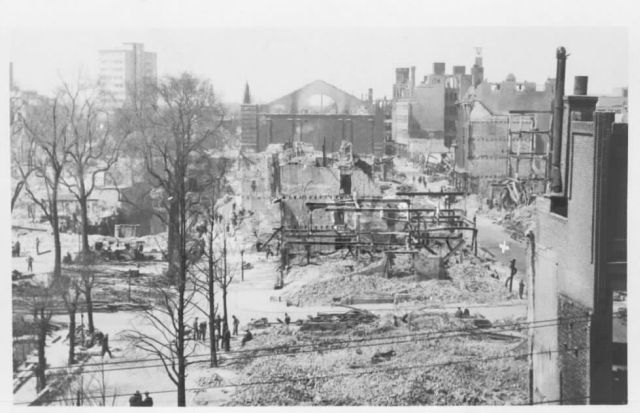 Destruction after the bombardment Source: Beeldbank WO2.
Destruction after the bombardment Source: Beeldbank WO2.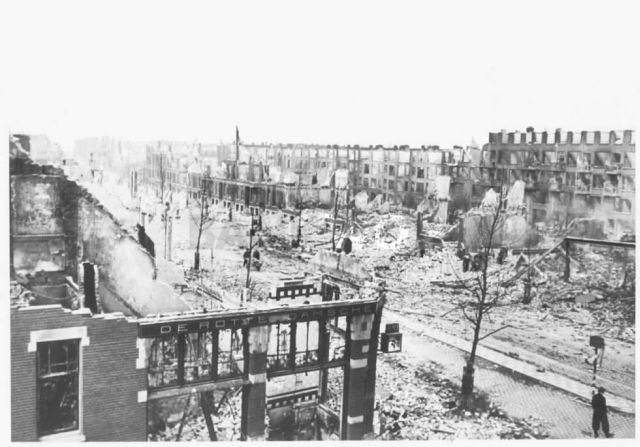 Destruction after the bombardment Source: Beeldbank WO2.
Destruction after the bombardment Source: Beeldbank WO2.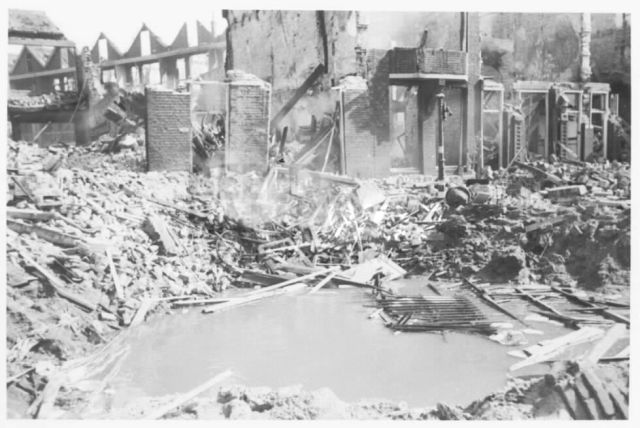 A bomb crater in the district Bospolder-Tussendijken Source: Beeldbank WO2.
A bomb crater in the district Bospolder-Tussendijken Source: Beeldbank WO2.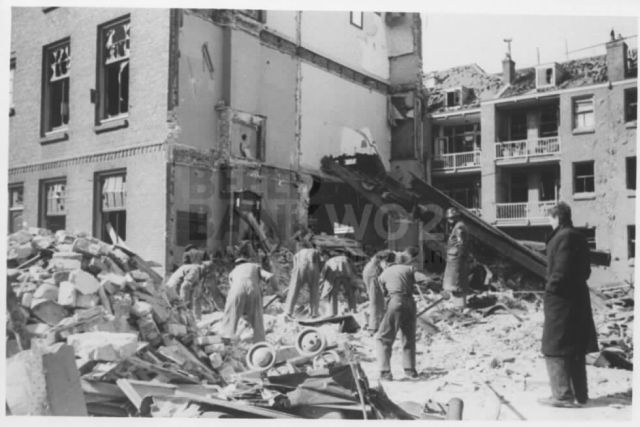 Searching for survivors after the bombardment Source: Beeldbank WO2.
Searching for survivors after the bombardment Source: Beeldbank WO2.







































:quality(80)/cdn-kiosk-api.telegraaf.nl/ae986afc-5583-11ea-988f-02c309bc01c1.jpg)
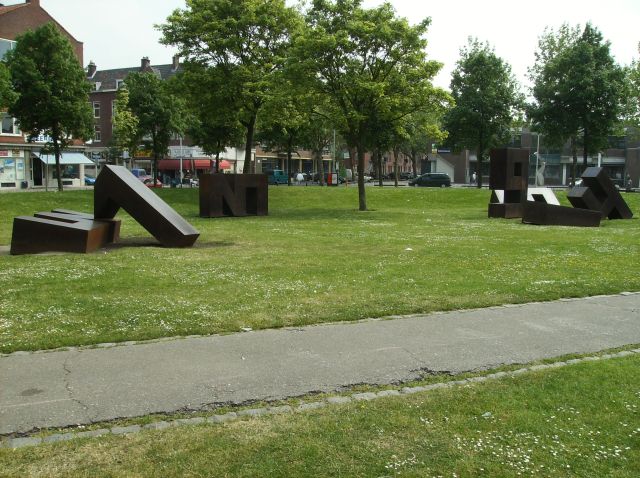
No comments:
Post a Comment